LES JEUNES À TABLE
Where young palates come of age
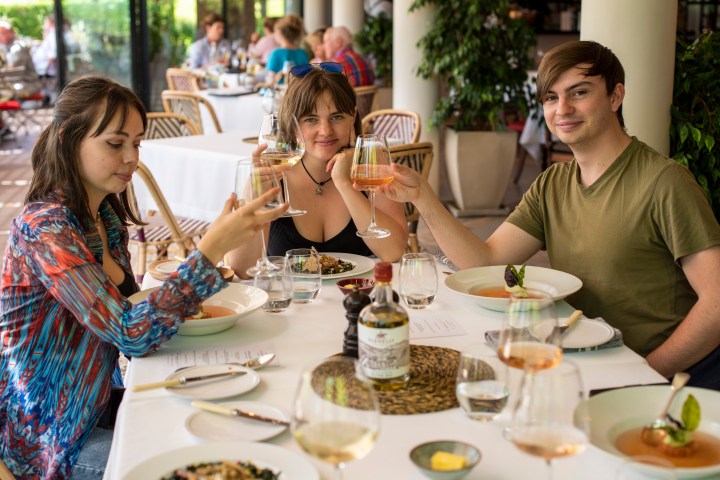
Exploring the finer side of dining is usually beyond your budget in your 20s, so how do you expand your culinary horizons and discover new flavours? Christophe Dehosse has the answer.
Chef Christophe Dehosse of The Vine Bistro at Glenelly in Stellenbosch, inspired by similar initiatives in his native France, has introduced Les Jeunes à Table, an affordable set menu with wine pairings, only for 18- to 29-year-olds.
As a student back in 1980s UK, the height of sophistication for us was eating out at a French crêperie called Fanny’s. Everything at Fanny’s was served in a pancake, savoury or sweet, and although I doubt how authentically French the fillings were, we felt cosmopolitan eating there. And yes, the offbeat clothes boutique next door was called Willie’s, it was a student town with a student sense of humour.
Today we have so many more varied cuisines on our doorsteps. Sushi was unheard of back then, now it’s ubiquitous. There are noodle bars and bao bars, Thai food and Korean, a lot of it served as street food and affordable now and then even on a student budget. But how does the younger generation take its first step beyond street food, excellent as it can be? Fine dining restaurants are out of reach to all but a few of that age group, and learning about good food comes with eating it.
I remember some of our family holidays when I was a teenager, driving through France with a hard-back Michelin guide to pick out a hotel for the night, then strolling around each new town reading the menus before deciding on where to eat that evening. My father chose small historic towns to stop in and there were always several restaurants around the centre ville, usually each with three or four prix fixe menus displayed. The cheapest would be basic and it was usually the second cheapest that had enough choice to keep everyone happy, deciphered with the aid of school-lesson French. It was an adventure and I’m sure we ate things that we would have never chosen if the menu had been in English. Ignorance was bliss.
But that kind of formative experience is not something that we have access to in South Africa and, as Christophe tells me later, the reliable excellence of small-town brasseries chosen at random can no longer be taken for granted, even in France. Which is where the Les Jeunes à Table initiative comes in – translated as “young people at table”.
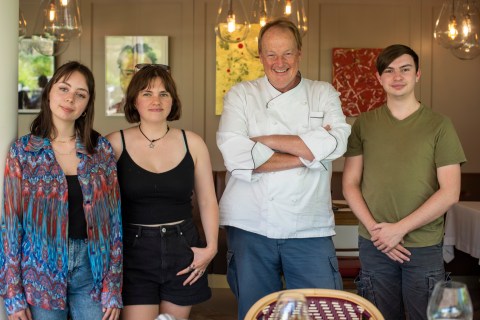
Chef Christophe Dehosse with today’s jeunes, my young adult kids. (Photo: Patrick Heathcock)
The idea at The Vine Bistro is to give young people a chance to enjoy a culinary adventure, making available one table per service to those aged 18-29, a set three course menu with wine pairings, water and coffee for R290 a head. The menu has two options per course and you specify any dietary requirements on booking. But it’s not about playing it safe. Christophe designs each menu to give you a chance to try new things. The Vine Bistro’s approach is very much the hearty French food I remember from my travels, but with South African and a few Asian influences too.
“People think that French cuisine is always hyper-sophisticated; it’s not,” says Christophe. “French food is similar to Italian food in that it’s very rustic. Until the beginning of the 20th century, 80% of France was living in the countryside. Very paysanne (country style) food. We eat a lot of offal, andouillette sausage, boudin, like a blood sausage.” Nose to tail eating is what he’s talking about, but he doesn’t propose to push Les Jeunes quite that far out of their comfort zones.
“For Les Jeunes à Table menu we try to put things that people don’t always have, you won’t find a steak. Today we’ve got pork cheeks, slowly braised, very tasty, served with a carrot mousseline and cauliflower mousseline and mustard sauce. Something you’d seldom cook at home.”
I’m at Vine Bistro for lunch with my three young adult children, plus my husband as photographer, and my mother who is visiting from the UK. Usually the Les Jeunes à Table menu is only for under 30s and for a maximum of four per table, but we have bent the rules so I can write this story. My son and daughters take in the stunning view over the vineyards and hills of Glenelly wine estate, the beautifully set table with white cloth, napkins and fine wine glasses.
This level of restaurant is a first for them, although they have occasionally accompanied me to review more informal eateries, and I fleetingly wish they’d had the exposure to travel and cuisines that I grew up with. When they were younger, eating out didn’t happen often. Pizzas were an occasional treat, or a café breakfast, but living out on a farm it was mostly home-cooked food, homemade jam and bread taken for granted. I once managed to feed them rabbit telling them it was chicken – the rabbit a gift, skinned and quartered, nothing to indicate its kinship with their fluffy pets. And they grew up with way more spices than I did, courtesy of The Madhur Jaffrey Cookbook, but real adventure in food still awaits them. Anyway, now they are being introduced to excellent French bistro cuisine from the best possible chef.
Christophe Dehosse grew up on a rural French farm, his mother cooking everything from scratch for the family and to feed all the farm workers at lunch, he says. “I always knew I wanted to work in, what we say in France, le metier de bouche – something food-related – I thought maybe a butcher or a pastry chef.” At 15 he went to the Ecole Jean Ferrandi hotel school affiliated to the Paris Chamber of Commerce and Industry, where they got hands-on experience every day at the in-house restaurant. “When I was 17, after graduating I started working at a 2-star Michelin fine dining restaurant nearby where I lived, et voilà.” He met his South African wife, Susan, when they were both working as chefs at the 2 star L’Auberge de Condé restaurant, and they moved back to South Africa thirty years ago. Christophe made a name for himself and his French cuisine as executive chef of Au Jardin at the Vineyard Hotel until 2001, when he and Susan joined her family’s business at Klein Joostenberg Farm and opened Joostenberg Bistro (still going strong), later going on to open The Vine Bistro at Glenelly Wine Estate in Stellenbosch.
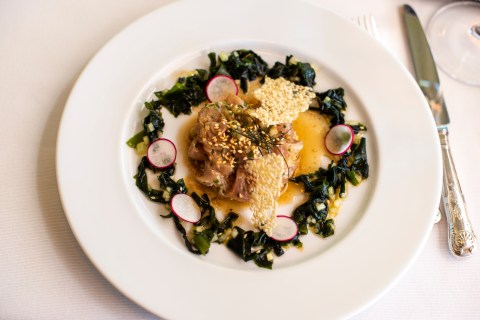
Sparking culinary adventure, the yellowtail ceviche brings Asian flavours of sesame, soy and wakame to the French bistro menu. (Photo: Patrick Heathcock)
Christophe and restaurant manager Mike Mpofu take plenty of time to explain each dish and answer any questions about the food and wine. Our starters are a choice between a chilled tomato consommé with cucumber salsa, and yellowtail ceviche with sesame, soya and coriander dressing. Christophe explains how they make the consommé by seasoning tomato with vinegar, onion and oil then leaving the juice to strain overnight, so that you get a clear juice fragrant with the essence of tomato, definitely not something I’d have the patience to make at home.
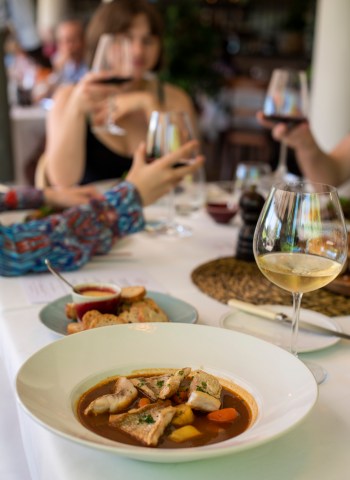
While I was the only one to order the bouillabaisse, the youngsters being put off by the mention of mussels and octopus, everyone enjoyed tasting from my bowl. (Photo: Patrick Heathcock)
The second main course option is bouillabaisse, a classic fish stew from the south of France, and I’m impressed that my son looks like he’s going to go for that, until Mike describes it in more detail – Harry is rather put off by the mention of mussels and octopus, stretching his gustatory wings just a bit too far. He’s the one that earned the label ‘picky eater’ as a child, although now at 23 he’s shocking his sisters by breaking the mould and trying things that he used to recoil from with horror.
I recently read a fascinating article in the New Yorker exploring the science of taste. Anne Fadiman, writes about visiting a taste researcher to find out why she had never been able to develop a taste for wine. She discovers that she just has more taste receptors, or papillae, on certain parts of her tongue than the average person and so is super sensitive, “Utermohlen (the taste scientist) left me with the impression that the term picky eater was invented by people with fewer papillae in order to diss people with more papillae,” she concludes. So maybe Harry and other people who were picky eaters as kids are just more sensitive to various tastes, and perhaps their twenties is the time to start enjoying that sensitivity by exploring the brightness of flavours that for the rest of us have faded to subtle nuances.
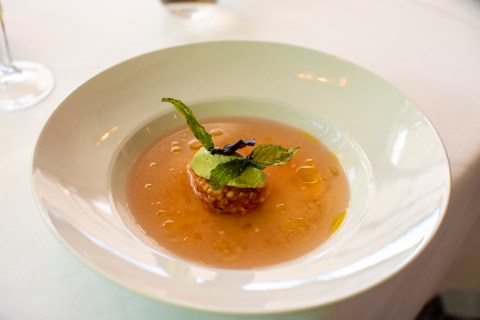
Chilled tomato consommé with cucumber salsa and crispy basil leaves, a labour of love that results in pure tomato freshness and is surprisingly filling. (Photo: Patrick Heathcock)
In fact while two of the family are exclaiming delightedly over the tomato consommé, how delicious it is, delicate and clear with a centrepiece of tomato pulp and cucumber salsa for texture and contrast, Harry is hesitant. “Too tomatoey, I’m coming round to tomatoes but not that much,” is his verdict, as he makes up for it with slices of baguette. Obviously still too sensitive to that particular spectrum of tastes. The ceviche is also excellent, generous quantities of yellowtail cured in a fresh dressing and surrounded by deep green wakame. Sky clears her plate, commenting succinctly, “Like sushi.”
The wine pairing is another part of the experience that is new territory for them. How does anyone develop an appreciation of wine? Remembering the faces they all pulled as teenagers when allowed a sip of our wine, and to be honest still do most of the time, it’s definitely a taste you have to work hard to acquire. I remember my father taking the education of my palate seriously enough to order a selection of semi-sweet German wines from the Wine Society when I was about 15 – they tasted of flowers and the word bouquet seemed a particularly apt descriptor. With that gentle introduction I proceeded confidently enough through cheap student plonk and emerged, palate hopefully unscathed, to learn a whole lot more about wine in my first real job, escorting clients on their Italian walking tours – nothing like having to guide a tasting of Brunello di Montalcino to get on first name terms with big red wines.
Today the Glenelly Glass Collection rosé paired with the tomato consommé got a vote of confidence from my youngest – being fresh and low in acidity, it’s excellent for those starting out on their wine journey. Mike gave us a Glenelly unoaked chardonnay with the ceviche, and an oaked chardonnay with the bouillabaisse, so we took the opportunity of all tasting each other’s glasses and comparing the differences, while Mike explained the basic principles of choosing wines to pair with each dish.
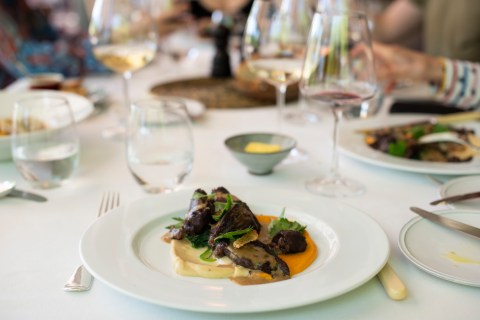
Chef Christophe Dehosse designs the Les Jeunes à Table menu to include dishes you probably wouldn’t find at home, like this slow braised pork cheek. (Photo: Patrick Heathcock)
Although a big red wine like cabernet sauvignon is a hard one for a newbie palate to get on good terms with, the kids admitted that tasting it paired with the braised pork cheek they could see the point of the food and wine pairing, the wine tasting less acidic and balancing the heaviness of the meat. And the pork cheek was a winner, “It actually tastes like beef, very rich,” Jamie said, “and the spinach is divine, the best I ever tasted.”
Les Jeunes à Table is a brilliant idea here in South Africa to introduce young people to new dining experiences, but when Christophe returns to chat, I ask him why such initiatives are needed in France, where I imagine children growing up eating out with their parents and drinking watered down wine with their meal from an early age, or has that changed?
“Eating well is still part of our culture,” Christophe says. He recalls taking his young family in 2006 to La Maison de Bricourt in Cancales, France, where Chef Olivier Roellinger was just about to receive his third Michelin star. “They had a degustation children’s menu, four courses, everything done the same as for the adults but in very tiny portions, one lamb cutlet beautifully trimmed with tarragon sauce and vegetables. A very small sole and the maitre d’ arrived at the table to clean and fillet it. The children are having the same experience as their parents, obviously at a reduced price and reduced portions adapted to their age.”
In France he says initiatives like Les Jeunes à Table are more about giving young people access to fine dining restaurants that they otherwise wouldn’t be able to afford, as well as wooing the next generation of diners. Later I research online and find similar schemes in Switzerland and Belgium, sometimes in the equivalent of restaurant week or month, other times throughout the winter season, all at hugely discounted prices. “Instead of spending 400 euro a head for a 3 star Michelin restaurant, they will spend maybe 200 euro,” Christophe says. “It’s still a lot of money but it’s feasible as a treat once or twice a year for a young professional couple.”
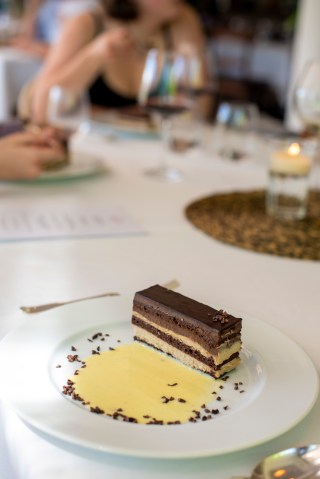
Opera cake proves to be a fabulously rich concoction of chocolate and coffee, served with a light vanilla cream custard. (Photo: Patrick Heathcock)
We chat some more about the economics of running a restaurant in France and just why those top restaurants are so eye-wateringly expensive. “It’s not the cost of the produce. France’s labour laws make staff costs very expensive,” Christophe says. These days only the top restaurants can afford to employ enough staff to do everything in-house. He observes that the individuality and quality of the small and medium restaurants is no longer what he experienced growing up, and what I remember from my holidays in the 80s, simply because they can’t afford the labour. Those places do still exist, perhaps with a couple doing everything themselves with just one or two employees, but are getting harder to find, replaced by brasseries where they buy in their casseroles and dishes vacuum-packed from huge industrial kitchens. This rather depressing perspective on the home of classic cuisine makes me feel a lot better about our family’s lack of food experiences outside South Africa. “Here we’re still making everything in house,” Christophe says, “so you get a lot more variety and individuality from restaurant to restaurant and it’s why tourists have such a great experience. The quality of restaurants in general in South Africa is incredible.”
Our lunch is rounded off with a choice of opera cake, a traditional French concoction of rich coffee and chocolate cake in a vanilla sauce that has us in immediate raptures, or a fabulous cheese board including French and South African cheese, with crisp toasts and chutney. And then just when we think we couldn’t eat another bite, with the coffee (also included in the set price menu) arrive pretty plates of tempting petits fours – macarons and truffles.
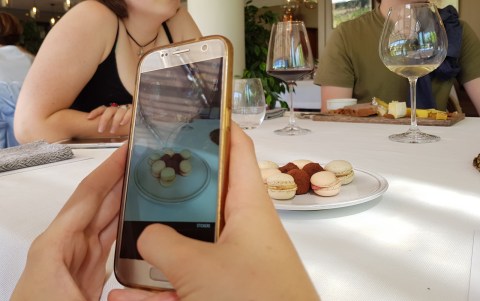
Coffee and water are included in the set price Les Jeunes à Table menu, with the sweet surprise of a plate of delicate petits fours, two different macarons and a truffle each. (Photo: Kit Heathcock)
With Les Jeunes à Table The Vine Bistro is investing in a future generation of diners, hoping to inspire a lifelong passion for good food and wine, “We have a town of 27,000 students here in Stellenbosch, so hopefully some of you are going to become doctors and lawyers, very successful, and you’ll come back every week,” Christophe laughs. In the meantime, until they are 30, our youngsters can splash out every now and again and develop a well-travelled palate at The Vine Bistro without even needing a passport. DM/TGIFood
Enquire and book for Les Jeunes à Table by email to [email protected] including a copy of an ID for each guest. Bookings open at the beginning of each month for the month ahead.
Follow Kit Heathcock on Instagram @kitheathcock
The writer supports Ladles of Love, feeding the hungry in the Western Cape and working on building long term solutions to hunger with the establishment of sustainable community kitchens. See Ladles of Love.






 Become an Insider
Become an Insider
Comments - Please login in order to comment.